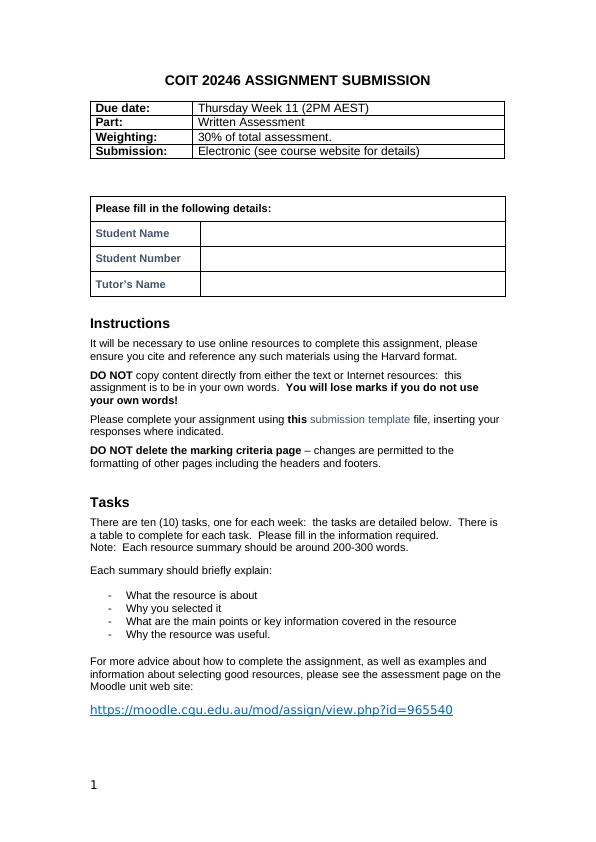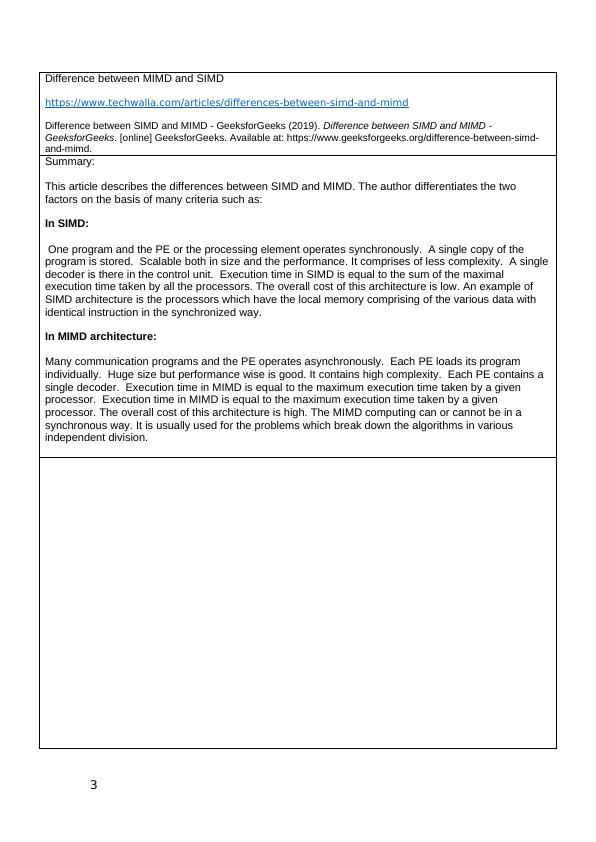Harvard Format Week Marks Awarded
Complete a written assessment using a submission template file, citing and referencing online resources in Harvard format.
12 Pages4289 Words18 Views
Added on 2022-09-16
Harvard Format Week Marks Awarded
Complete a written assessment using a submission template file, citing and referencing online resources in Harvard format.
Added on 2022-09-16
ShareRelated Documents
COIT 20246 ASSIGNMENT SUBMISSION
Due date: Thursday Week 11 (2PM AEST)
Part: Written Assessment
Weighting: 30% of total assessment.
Submission: Electronic (see course website for details)
Please fill in the following details:
Student Name
Student Number
Tutor’s Name
Instructions
It will be necessary to use online resources to complete this assignment, please
ensure you cite and reference any such materials using the Harvard format.
DO NOT copy content directly from either the text or Internet resources: this
assignment is to be in your own words. You will lose marks if you do not use
your own words!
Please complete your assignment using this submission template file, inserting your
responses where indicated.
DO NOT delete the marking criteria page – changes are permitted to the
formatting of other pages including the headers and footers.
Tasks
There are ten (10) tasks, one for each week: the tasks are detailed below. There is
a table to complete for each task. Please fill in the information required.
Note: Each resource summary should be around 200-300 words.
Each summary should briefly explain:
- What the resource is about
- Why you selected it
- What are the main points or key information covered in the resource
- Why the resource was useful.
For more advice about how to complete the assignment, as well as examples and
information about selecting good resources, please see the assessment page on the
Moodle unit web site:
https://moodle.cqu.edu.au/mod/assign/view.php?id=965540
1
Due date: Thursday Week 11 (2PM AEST)
Part: Written Assessment
Weighting: 30% of total assessment.
Submission: Electronic (see course website for details)
Please fill in the following details:
Student Name
Student Number
Tutor’s Name
Instructions
It will be necessary to use online resources to complete this assignment, please
ensure you cite and reference any such materials using the Harvard format.
DO NOT copy content directly from either the text or Internet resources: this
assignment is to be in your own words. You will lose marks if you do not use
your own words!
Please complete your assignment using this submission template file, inserting your
responses where indicated.
DO NOT delete the marking criteria page – changes are permitted to the
formatting of other pages including the headers and footers.
Tasks
There are ten (10) tasks, one for each week: the tasks are detailed below. There is
a table to complete for each task. Please fill in the information required.
Note: Each resource summary should be around 200-300 words.
Each summary should briefly explain:
- What the resource is about
- Why you selected it
- What are the main points or key information covered in the resource
- Why the resource was useful.
For more advice about how to complete the assignment, as well as examples and
information about selecting good resources, please see the assessment page on the
Moodle unit web site:
https://moodle.cqu.edu.au/mod/assign/view.php?id=965540
1

Example
The “Internet of things” is an emerging trend towards smart interconnected embedded technologies that
allow us to monitor and control our environment. Collect and summarise an online resource that describes
ONE example or application of the Internet of things.
Title, Link and Reference:
Connected Medical Devices, Apps: Are They Leading the IoT Revolution — or Vice Versa?
https://www.wired.com/insights/2014/06/connected-medical-devices-apps-leading-iot-revolution-vice-versa/
Lars, N 2014, ‘Connected Medical Devices, Apps: Are They Leading the IoT Revolution — or Vice Versa?’,
Wired, June 2014, viewed 1 February 2017,
https://www.wired.com/insights/2014/06/connected-medical-devices-apps-leading-iot-revolution-vice-versa/
Note: You may use abbreviated URLs (to the website) in the reference, however you must provide the
FULL link above it that, when pasted into the Web Browser, will take the marker directly to the resource.
Using full URLs in the reference (as in this example) is fine too.
Summary:
Connected Medical Devices, Apps: Are They Leading the IoT Revolution — or Vice Versa?
This article describes the emergence of the Internet of Things (IoT) in the context of medical devices. I
chose this article because it not only examines the applications of a very useful class of IoT devices, but it
also highlights the need for ways of collecting and processing the data they produce.
In the article, the author describes how many medical monitoring devices are now capable of connecting to
the Internet and are becoming a normal part of patient care. These devices allow remote monitoring of
patient health wirelessly and can collect data on a wide range of vital signs and indicators. Data can be
collected from a range of sensors reading everything from heart rate and blood pressure through to blood
sugar levels and temperature.
In addition to passive monitors, IoT medical devices provide the ability to proactively prompt patients to do
things, for example to warn them of their blood pressure or to alert them that they need more medication.
The article points out that many of these notifications are the result of apps (software) interacting with both
the devices and the patients.
Perhaps the most interesting aspect of the article is the author’s discussion of what happens to the data that
the IoT medical devices produce. The author explains that many devices can send data directly to the cloud
for storage and analysis and that this data constitutes a wealth of information that will potentially improve
healthcare in the future.
I found this article useful because it not only highlighted the increasing ubiquity of Internet-connected
medical devices, but also made me think about how the data is collected, where it is stored and how it could
be used – both positively and negatively – in the future.
Week 1
The text discusses about different architectures for parallel processing used for Multiprocessor
Machines such as multiple-instruction stream - multiple-data stream (MIMD), single-instruction stream -
multiple-data stream (SIMD) etc. Find and summarise ONE resource that compares between MIMD
and SIMD architectures. The resource, and your summary, must focus only on MIMD and SIMD
architectures.
2
The “Internet of things” is an emerging trend towards smart interconnected embedded technologies that
allow us to monitor and control our environment. Collect and summarise an online resource that describes
ONE example or application of the Internet of things.
Title, Link and Reference:
Connected Medical Devices, Apps: Are They Leading the IoT Revolution — or Vice Versa?
https://www.wired.com/insights/2014/06/connected-medical-devices-apps-leading-iot-revolution-vice-versa/
Lars, N 2014, ‘Connected Medical Devices, Apps: Are They Leading the IoT Revolution — or Vice Versa?’,
Wired, June 2014, viewed 1 February 2017,
https://www.wired.com/insights/2014/06/connected-medical-devices-apps-leading-iot-revolution-vice-versa/
Note: You may use abbreviated URLs (to the website) in the reference, however you must provide the
FULL link above it that, when pasted into the Web Browser, will take the marker directly to the resource.
Using full URLs in the reference (as in this example) is fine too.
Summary:
Connected Medical Devices, Apps: Are They Leading the IoT Revolution — or Vice Versa?
This article describes the emergence of the Internet of Things (IoT) in the context of medical devices. I
chose this article because it not only examines the applications of a very useful class of IoT devices, but it
also highlights the need for ways of collecting and processing the data they produce.
In the article, the author describes how many medical monitoring devices are now capable of connecting to
the Internet and are becoming a normal part of patient care. These devices allow remote monitoring of
patient health wirelessly and can collect data on a wide range of vital signs and indicators. Data can be
collected from a range of sensors reading everything from heart rate and blood pressure through to blood
sugar levels and temperature.
In addition to passive monitors, IoT medical devices provide the ability to proactively prompt patients to do
things, for example to warn them of their blood pressure or to alert them that they need more medication.
The article points out that many of these notifications are the result of apps (software) interacting with both
the devices and the patients.
Perhaps the most interesting aspect of the article is the author’s discussion of what happens to the data that
the IoT medical devices produce. The author explains that many devices can send data directly to the cloud
for storage and analysis and that this data constitutes a wealth of information that will potentially improve
healthcare in the future.
I found this article useful because it not only highlighted the increasing ubiquity of Internet-connected
medical devices, but also made me think about how the data is collected, where it is stored and how it could
be used – both positively and negatively – in the future.
Week 1
The text discusses about different architectures for parallel processing used for Multiprocessor
Machines such as multiple-instruction stream - multiple-data stream (MIMD), single-instruction stream -
multiple-data stream (SIMD) etc. Find and summarise ONE resource that compares between MIMD
and SIMD architectures. The resource, and your summary, must focus only on MIMD and SIMD
architectures.
2

Difference between MIMD and SIMD
https://www.techwalla.com/articles/differences-between-simd-and-mimd
Difference between SIMD and MIMD - GeeksforGeeks (2019). Difference between SIMD and MIMD -
GeeksforGeeks. [online] GeeksforGeeks. Available at: https://www.geeksforgeeks.org/difference-between-simd-
and-mimd.
Summary:
This article describes the differences between SIMD and MIMD. The author differentiates the two
factors on the basis of many criteria such as:
In SIMD:
One program and the PE or the processing element operates synchronously. A single copy of the
program is stored. Scalable both in size and the performance. It comprises of less complexity. A single
decoder is there in the control unit. Execution time in SIMD is equal to the sum of the maximal
execution time taken by all the processors. The overall cost of this architecture is low. An example of
SIMD architecture is the processors which have the local memory comprising of the various data with
identical instruction in the synchronized way.
In MIMD architecture:
Many communication programs and the PE operates asynchronously. Each PE loads its program
individually. Huge size but performance wise is good. It contains high complexity. Each PE contains a
single decoder. Execution time in MIMD is equal to the maximum execution time taken by a given
processor. Execution time in MIMD is equal to the maximum execution time taken by a given
processor. The overall cost of this architecture is high. The MIMD computing can or cannot be in a
synchronous way. It is usually used for the problems which break down the algorithms in various
independent division.
3
https://www.techwalla.com/articles/differences-between-simd-and-mimd
Difference between SIMD and MIMD - GeeksforGeeks (2019). Difference between SIMD and MIMD -
GeeksforGeeks. [online] GeeksforGeeks. Available at: https://www.geeksforgeeks.org/difference-between-simd-
and-mimd.
Summary:
This article describes the differences between SIMD and MIMD. The author differentiates the two
factors on the basis of many criteria such as:
In SIMD:
One program and the PE or the processing element operates synchronously. A single copy of the
program is stored. Scalable both in size and the performance. It comprises of less complexity. A single
decoder is there in the control unit. Execution time in SIMD is equal to the sum of the maximal
execution time taken by all the processors. The overall cost of this architecture is low. An example of
SIMD architecture is the processors which have the local memory comprising of the various data with
identical instruction in the synchronized way.
In MIMD architecture:
Many communication programs and the PE operates asynchronously. Each PE loads its program
individually. Huge size but performance wise is good. It contains high complexity. Each PE contains a
single decoder. Execution time in MIMD is equal to the maximum execution time taken by a given
processor. Execution time in MIMD is equal to the maximum execution time taken by a given
processor. The overall cost of this architecture is high. The MIMD computing can or cannot be in a
synchronous way. It is usually used for the problems which break down the algorithms in various
independent division.
3

4

End of preview
Want to access all the pages? Upload your documents or become a member.
Related Documents
COIT 20246 Assignment Submissionlg...
|16
|5014
|252
COIT Submission Assignment 2022.lg...
|13
|5002
|12
Coit 20246 Submission Assignment 2022lg...
|14
|4610
|12
Coit-20246 Submission Assignment 2022lg...
|13
|5506
|6
Case Study Of Internet Of Thingslg...
|14
|5545
|10
Coit 20246 Assignment Submission 2022lg...
|17
|5121
|16
